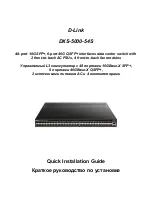
Ruckus ICX 7850 Switch Hardware Installation Guide
11
Part Number: 53-1005580-01
Preparing for Installation
Facility Requirements
•
Allow for twisted-pair cables to be routed away from power lines, fluorescent lighting fixtures, and other sources of electrical
interference, such as radios and transmitters.
•
Allow for the unit to be connected to a separate grounded power outlet that provides 100 to 240 VAC, 50 to 60 Hz, is within
2 m (6.6 ft) of each device, and is powered from an independent circuit breaker. As with any equipment, a filter or surge
suppressor is recommended.
Rack Considerations
For successful installation and operation of the device in a rack, ensure the following rack requirements are met:
•
The rack must be a standard EIA rack.
•
The equipment in the rack is grounded through a reliable branch circuit connection and maintains ground at all times. Do not rely
on a secondary connection to a branch circuit, such as a power strip.
•
Airflow and temperature requirements are met on an continual basis, particularly if the device is installed in a closed or multirack
assembly.
•
The additional weight of the device does not exceed the rack’s weight limits or unbalance the rack in any way.
•
The rack is secured to ensure stability in case of unexpected movement, such as an earthquake.
Recommendations for Cable Management
Cables can be organized and managed in a variety of ways; for example, use cable channels on the sides of the rack or patch panels to
reduce the potential for tangling the cables. The following list provides some recommendations for cable management:
NOTE
You should not use tie wraps with fiber-optic cables because they are easily overtightened and can damage the optical fibers.
Velcro-like wraps are recommended.
•
Plan for the rack space required for cable management before installing the device.
•
Leave at least 1 m (3.28 ft) of slack for each port cable. This provides room to remove and replace the device, allows for
inadvertent movement of the rack, and helps prevent the cables from being bent to less than the minimum bend radius.
•
For easier maintenance, label the cables and record the devices to which they are connected.
•
Keep LEDs visible by routing port cables and other cables away from the LEDs.
CAUTION
Before plugging a cable to any port, be sure to discharge any static charge stored on the cable by touching the electrical
contacts to ground surface.
















































